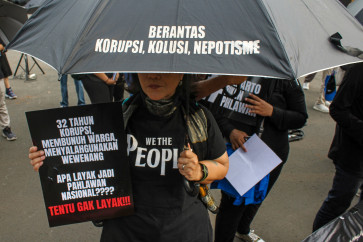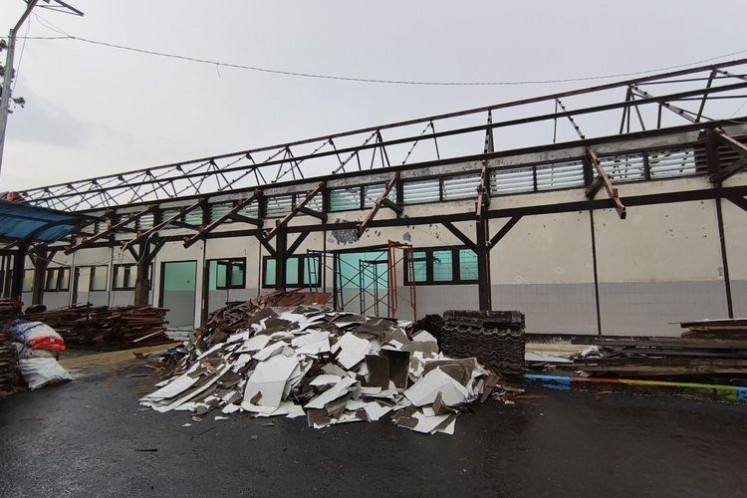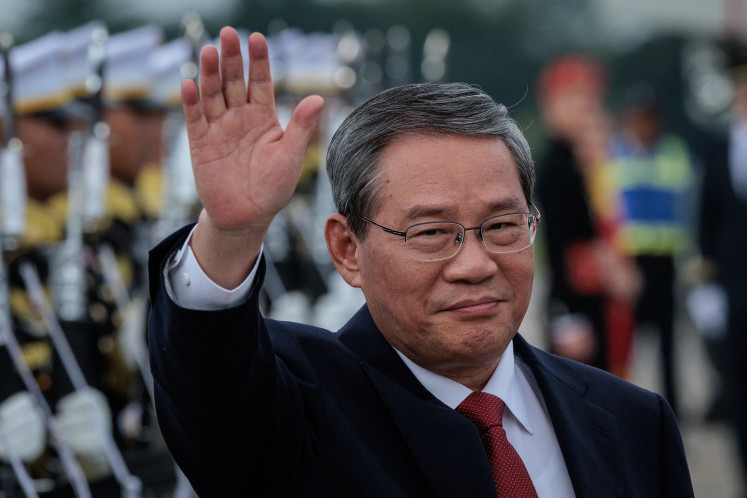Welcoming the new horizon at Candi Sukuh
Grace: Estefania Piffano from Venezuela performs on the second day of the annual Srawung Seni Candi
Change text size
Gift Premium Articles
to Anyone

G
span class="caption" style="width: 398px;">Grace: Estefania Piffano from Venezuela performs on the second day of the annual Srawung Seni Candi.A woman appeared as if emerging from the mist, walking along temple steps leading to an adjacent yard. Gazing ahead, the woman in red proceeded with her arms folded over blossoms of kamboja (frangipani) flowers.
At the end of the steps she paused. Her hands started moving, allowing the flowers to drop, and her body swayed in slow, graceful motion. She then went down the steps very slowly and lay down at the bottom of the stairs.
In a quarter of an hour, the Agape dance performed by the young choreographer from the Indonesian Arts Institute in Surakarta was over.
“Agape is derived from Greek, meaning endless love. This dance is about universal love, not just personal love,” said dancer Agustin Intan at the 8th Srawung Seni Candi festival, a gathering of artists at Candi Sukuh in Karanganyar, Central Java, on Jan. 1.
What Intan presented, however, wasn’t anything like a dance. With mostly deliberate, slow paces, she hardly offered any other movements. The flowers, meant to symbolize eternal love, fell with no other corresponding gestures. While on the temple steps, the dancer looked more like she was posing for pre-wedding pictures than performing a dance.
Choreographer Mugiyono Kasido appeared earlier together with his family to perform Bima Maja, his version of the famous Dewa Ruci episode in the Mahabharata in which Bima seeks spiritual power through sacred water. In Bima’s typical black-and-white checkered costume, Mugiyono played the character with an air of valor, though this time Bima as the hero sought maja fruit instead of water. 
Mugiyono did explore the space around him. After dominating the yard, he jumped onto the temple floor to respond to the reliefs of the Pandawa brothers, of which Bima is one. He eventually skirted the right side of the temple and returned to the open yard.
Riyanto from Solo stunned the audience on the second day of Srawung Seni Candi together with nine female dancers. He performed Lelananging Jagad, the story of a victorious hero in battle who is also an amorous man. Using the temple’s turtle-shaped altar, Riyanto began by lying on the ritual table. Eight women emerged from the back and another from the front who moved toward the altar. She sat on Riyanto and he promptly rose to hug her. 
The first day of the event on Dec. 31, 2011 saw several foreign artists such as Russia’s Yana KM with Wind of Change, a story of the Goddess Betari Durga. She performed an interpretation of the reliefs of Sang Dewi Angkara (the Goddess of Wrath) on the walls of Candi Sukuh.
Yana played the character herself, clad in all black with clothes stuffed to make her body look inflated like a monster, complete with two pairs of arms. Emerging out of the dim light of a Garuda statue, she moved quickly to the temple altar. On the giant turtle, Betari Durga moved, scattering petals and swaying as if desiring to spread terror.
A moment later her movements changed and became gentle after entering a dark alley — actually a main gate to the temple. When she reappeared at the temple’s peak, her monster costume had become the attire of a princess. “One always has two sides of one’s personality, the good and the ugly, white and black. It’s my other interpretation of Betari Durga,” said Yana after the show.
Other highlights of the first day were Ines Somellera and Juliana Faesler. The Mexican artists, practicing meditation in motion with Suprapto Suryodarmo, presented Offering a Lullaby, a dance of temple veneration.
They illustrated the literal side of worship by pressing their bodies against a temple wall with serene expressions on their faces. Only now and then did they move their hands slowly from their chests to their faces. There were no other motions.
“About 50 artists and cultural experts joined the temple art event this year. Their number has been increasing. I’m very pleased because it also means a lot more people are interested in preserving art and culture,” said program organizer Suprapto Suryodarmo.
Some of the other artists participating in the event were the Sahita theater-dance group from Solo, Lynda Bransbury from Britain and Estefania Piffano from Venezuela. Besides the artists, hundreds of visitors from Solo, Yogyakarta, Bali, Bandung and Jakarta crowded Candi Sukuh for the two days of the festival.
“That was how we saw off the old sun and welcomed the new horizon,” Suprapto said.
— Photos By JP/Ganug Nugroho Adi









